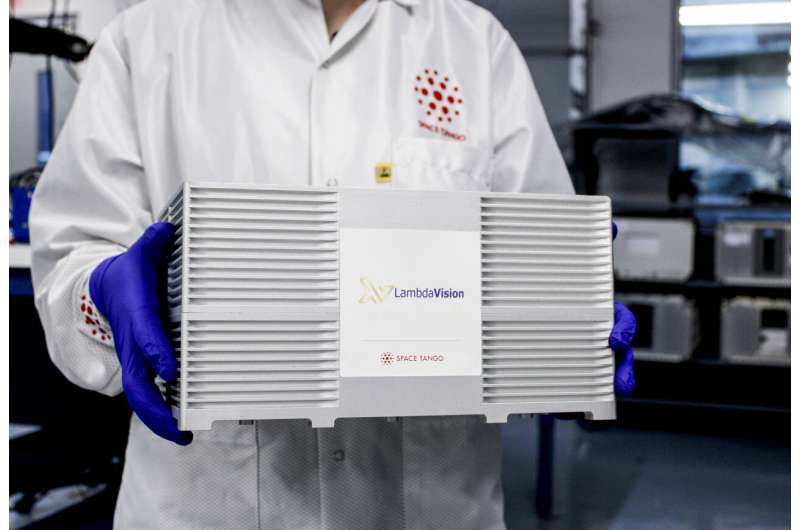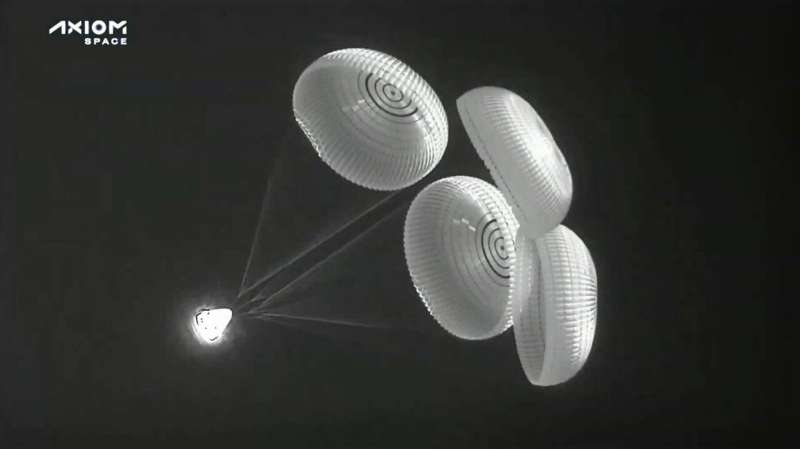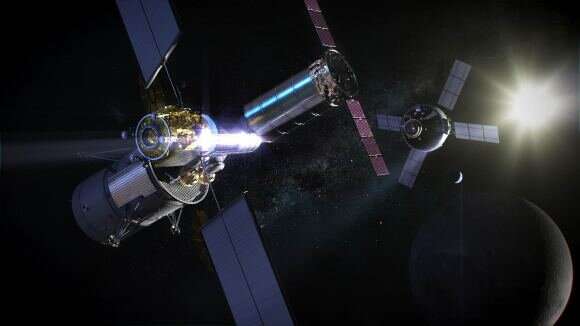Meteorites from the red desert of Australia support search for life on the red planet Mars
Tuesday, 26 April 2022 03:00 Monash University, University of Queensland and Australian National University researchers have used ANSTO's Australian Synchrotron in their study of meteorites found on Earth that could be used in future to find evidence of life on the planet Mars.
The examination of meteorites recovered from the Nullarbor Plain in western South Australia by a joint team that included Dr Andrew Langendam
Monash University, University of Queensland and Australian National University researchers have used ANSTO's Australian Synchrotron in their study of meteorites found on Earth that could be used in future to find evidence of life on the planet Mars.
The examination of meteorites recovered from the Nullarbor Plain in western South Australia by a joint team that included Dr Andrew Langendam New geological research shows Mars may have been more habitable than we thought
Tuesday, 26 April 2022 03:00 New research by Dr. Steve Grasby, Research Scientist at Natural Resource Canada's Geological Survey of Canada, could indicate a more habitable environment than previously thought for the red planet, Mars.
Located on the northernmost point of mainland Northwest Territories, Canada, the Smoking Hills (Inuvialuit name "Ingniryuat") are a unique geological formation. Named after the smoke crea
New research by Dr. Steve Grasby, Research Scientist at Natural Resource Canada's Geological Survey of Canada, could indicate a more habitable environment than previously thought for the red planet, Mars.
Located on the northernmost point of mainland Northwest Territories, Canada, the Smoking Hills (Inuvialuit name "Ingniryuat") are a unique geological formation. Named after the smoke crea China looking at sending robotic probe to far side of moon
Tuesday, 26 April 2022 03:00 Chinese scientists and engineers are considering sending a robotic probe to collect dust and rocks from the far side of the moon, an ambitious endeavor that will likely make it a world's first, said a senior space agency official.
Wu Yanhua, deputy director of the China National Space Administration, said on Friday that the United States, Russia and China have brought lunar substances back
Chinese scientists and engineers are considering sending a robotic probe to collect dust and rocks from the far side of the moon, an ambitious endeavor that will likely make it a world's first, said a senior space agency official.
Wu Yanhua, deputy director of the China National Space Administration, said on Friday that the United States, Russia and China have brought lunar substances back China starts engineering development of lunar exploration program's fourth phase
Tuesday, 26 April 2022 03:00 China will start engineering development of the fourth phase of its lunar exploration program this year, according to a senior official of the China National Space Administration on Sunday.
The Chang'e 6, Chang'e 7 and Chang'e-8 lunar probes will be launched successively, and the country will endeavor to make breakthroughs in key technologies and build an international lunar research stati
China will start engineering development of the fourth phase of its lunar exploration program this year, according to a senior official of the China National Space Administration on Sunday.
The Chang'e 6, Chang'e 7 and Chang'e-8 lunar probes will be launched successively, and the country will endeavor to make breakthroughs in key technologies and build an international lunar research stati China developing defense against near-Earth asteroids
Tuesday, 26 April 2022 03:00 China has begun to develop a defense system against near-Earth asteroids that could potentially hit Earth, according to a key figure in the country's space industry.
Wu Yanhua, deputy director of the China National Space Administration, said on Friday that China has started forming a research and development system for defense against near-Earth asteroids, to improve the world's capability
China has begun to develop a defense system against near-Earth asteroids that could potentially hit Earth, according to a key figure in the country's space industry.
Wu Yanhua, deputy director of the China National Space Administration, said on Friday that China has started forming a research and development system for defense against near-Earth asteroids, to improve the world's capability China mulls building defense system against near-Earth asteroids
Tuesday, 26 April 2022 03:00 China is set to build monitoring and defense systems protecting the planet from the dangers of near-Earth asteroids (NEAs).
Wu Yanhua, deputy director of the China National Space Administration (CNSA), told China's CCTV News recently that China will start to build an Earth-based and space-based NEA monitoring and warning system, in order to ensure the safe, stable and orderly operation of
China is set to build monitoring and defense systems protecting the planet from the dangers of near-Earth asteroids (NEAs).
Wu Yanhua, deputy director of the China National Space Administration (CNSA), told China's CCTV News recently that China will start to build an Earth-based and space-based NEA monitoring and warning system, in order to ensure the safe, stable and orderly operation of Vice Adm. Sharp: Commercial satellites a key counterforce to Russian disinformation
Monday, 25 April 2022 18:28
Geospatial intelligence has been "instrumental to those fighting in Ukraine, and to shaping worldviews of the crisis,” said Vice Adm. Robert Sharp, director of the National Geospatial Intelligence Agency.
The post Vice Adm.
Crew-4 astronauts head to space station to conduct microgravity science
Monday, 25 April 2022 18:08
NASA's SpaceX Crew-4 mission, originally scheduled to launch to the International Space Station on Saturday, April 23, from NASA's Kennedy Space Center in Florida, has been rescheduled to Wednesday, April 27. This launch carries three NASA astronauts—Kjell Lindgren, Robert Hines, and Jessica Watkins—and ESA (European Space Agency) astronaut Samantha Cristoforetti. This spaceflight is the first for Hines and Watkins and the second for Lindgren and Cristoforetti.
Here are details on some of the research riding with the crew aboard the SpaceX Dragon Freedom capsule into low-Earth orbit:
Replacement retinas
Artificial retinas could restore meaningful vision for the millions of people on Earth who suffer from retinal degenerative diseases, including retinitis pigmentosa and age-related macular degeneration. The ISS National Lab-sponsored study Protein-Based Artificial Retina Manufacturing evaluates a manufacturing process to develop artificial human retinas using a light-activated protein called bacteriorhodopsin, which could replace the function of damaged light-sensing cells in the eye.
Rich trio back on Earth after charter trip to space station
Monday, 25 April 2022 16:46
Three rich businessmen returned from the International Space Station with their astronaut escort Monday, wrapping up a pricey trip that marked NASA's debut as a B&B host.
Crew Dragon splashes down to end Ax-1 private astronaut mission
Monday, 25 April 2022 16:25
A Crew Dragon spacecraft returned to Earth April 25, ending a 17-day mission that ferried four private astronauts to and from the International Space Station.
The post Crew Dragon splashes down to end Ax-1 private astronaut mission appeared first on SpaceNews.
Starlink secures first major airline Wi-Fi deal with Hawaiian Airlines
Monday, 25 April 2022 14:21
Hawaiian Airlines said April 25 it plans to offer free Starlink services on transpacific flights to and from Hawaii next year, becoming the first major airline to announce a deal with SpaceX’s high-speed broadband network.
The post Starlink secures first major airline Wi-Fi deal with Hawaiian Airlines appeared first on SpaceNews.
Planetary Decadal Survey says it's time for a mission to Uranus (and Enceladus too)
Monday, 25 April 2022 14:20
Since 2002, the United States National Research Council (NRC) has released a publication that identifies objectives and makes recommendations for science missions for NASA, the National Science Foundation, and other government agencies for the next decade. These reports, appropriately named Planetary Science Decadal Surveys, help inform future NASA missions that address the mysteries that persist in astronomy, astrophysics, earth science, and heliophysics.
On Thursday, April 19th, in a briefing in Washington D.C., the National Academies of Sciences, Engineering, and Medicine (NASEM) shared the main findings of the Planetary Science and Astrobiology Decadal Survey 2023–2032. The event was live-streamed and consisted of NASEM committee members discussing the key science questions, priority missions, and research strategies identified and recommended, followed by a Q&A session with the audience.
ManTech tracking foreign influence using open-source intelligence
Monday, 25 April 2022 13:40
ManTech developed a model that uses open-source intelligence to measure the level of foreign influence in any country
The post ManTech tracking foreign influence using open-source intelligence appeared first on SpaceNews.
A boom in Earth observation satellites creating new demands for intelligence
Monday, 25 April 2022 12:26
Crises such as the covid pandemic, climate change and the war in Ukraine are fueling demand for geospatial information
The post A boom in Earth observation satellites creating new demands for intelligence appeared first on SpaceNews.
Capella raises $97 million to expand radar constellation
Monday, 25 April 2022 12:00
Capella Space raised $97 million in a Series C investment round.
The post Capella raises $97 million to expand radar constellation appeared first on SpaceNews.

